Representation of the People Act 1918 Worksheets
Do you want to save dozens of hours in time? Get your evenings and weekends back? Be able to teach about the Representation of the People Act 1918 to your students?
Our worksheet bundle includes a fact file and printable worksheets and student activities. Perfect for both the classroom and homeschooling!
Resource Examples
Click any of the example images below to view a larger version.
Fact File
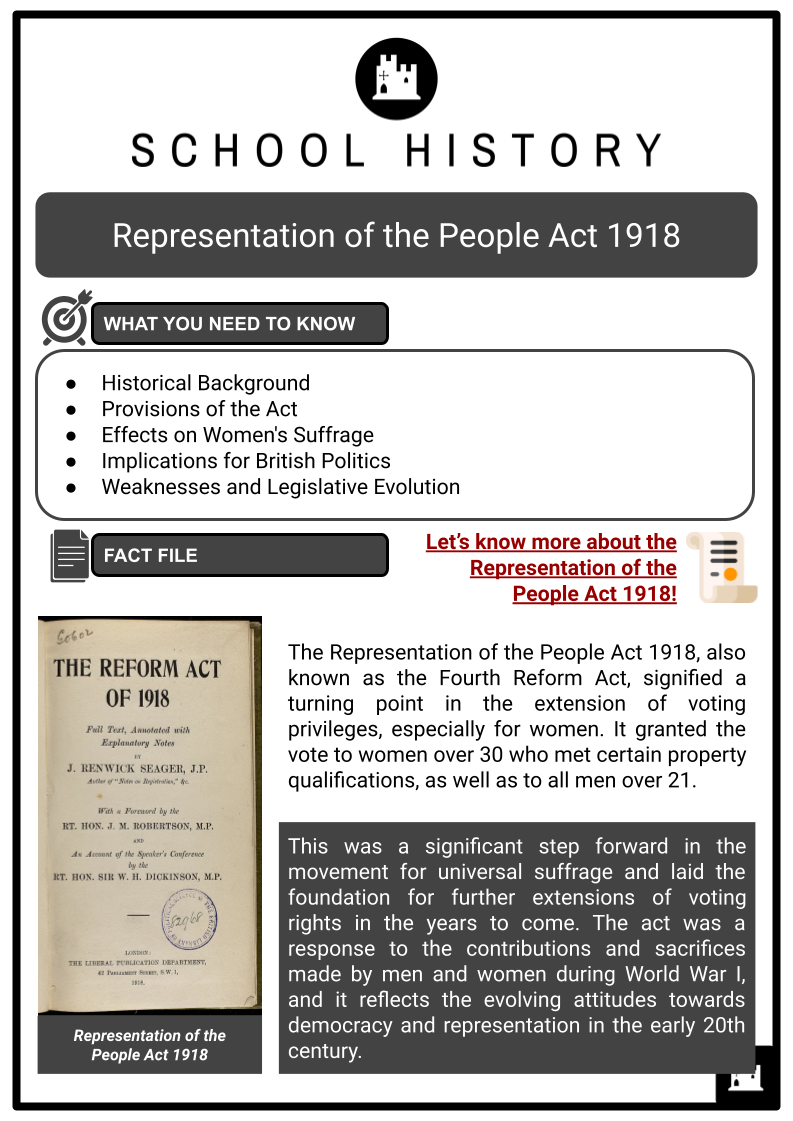
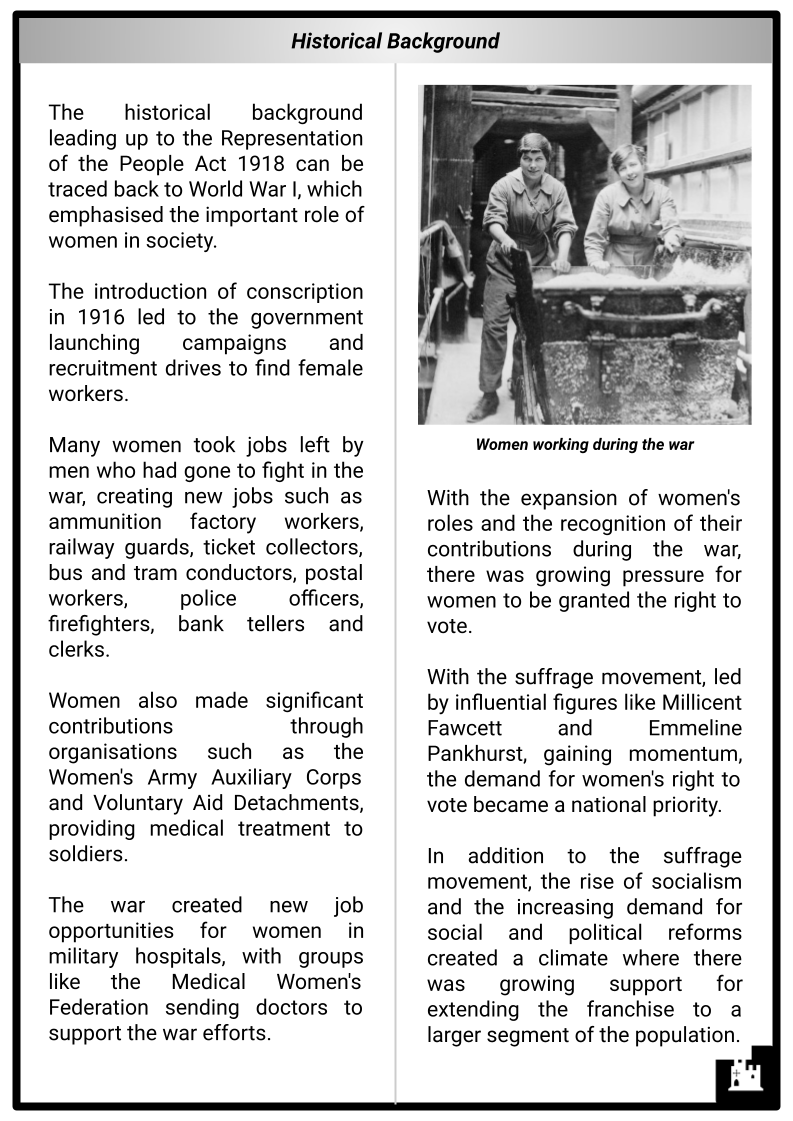
Student Activities
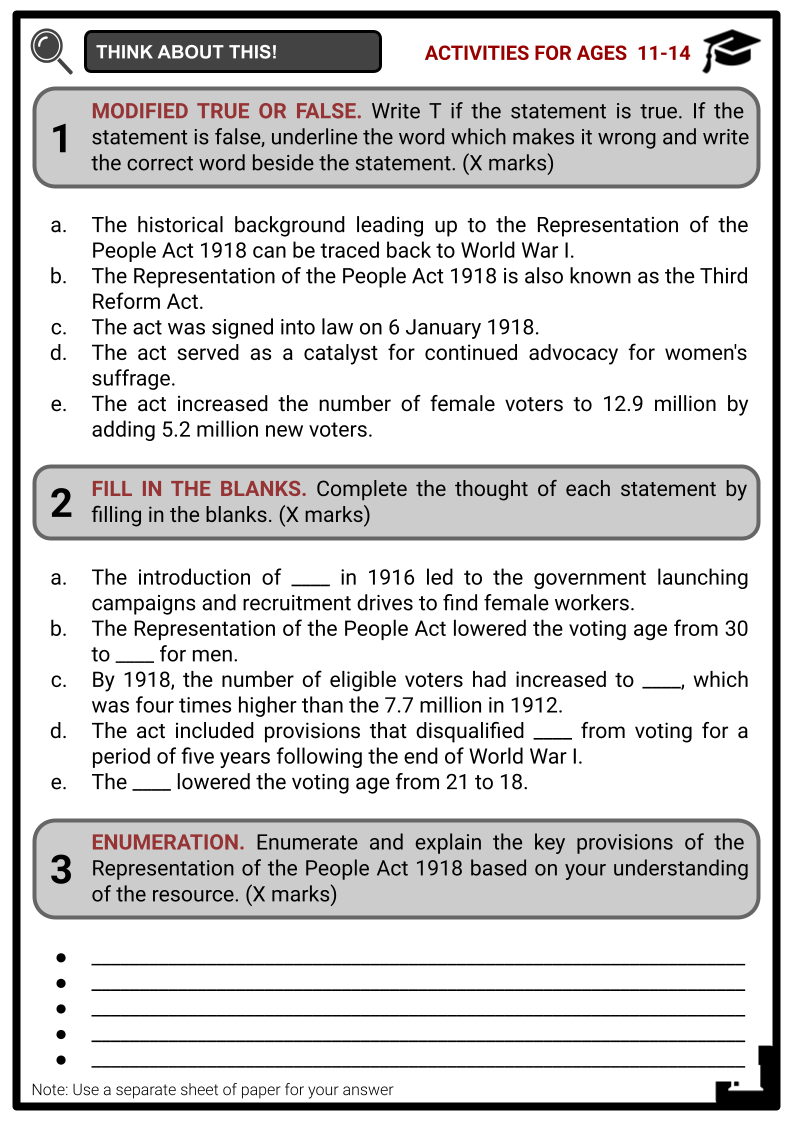
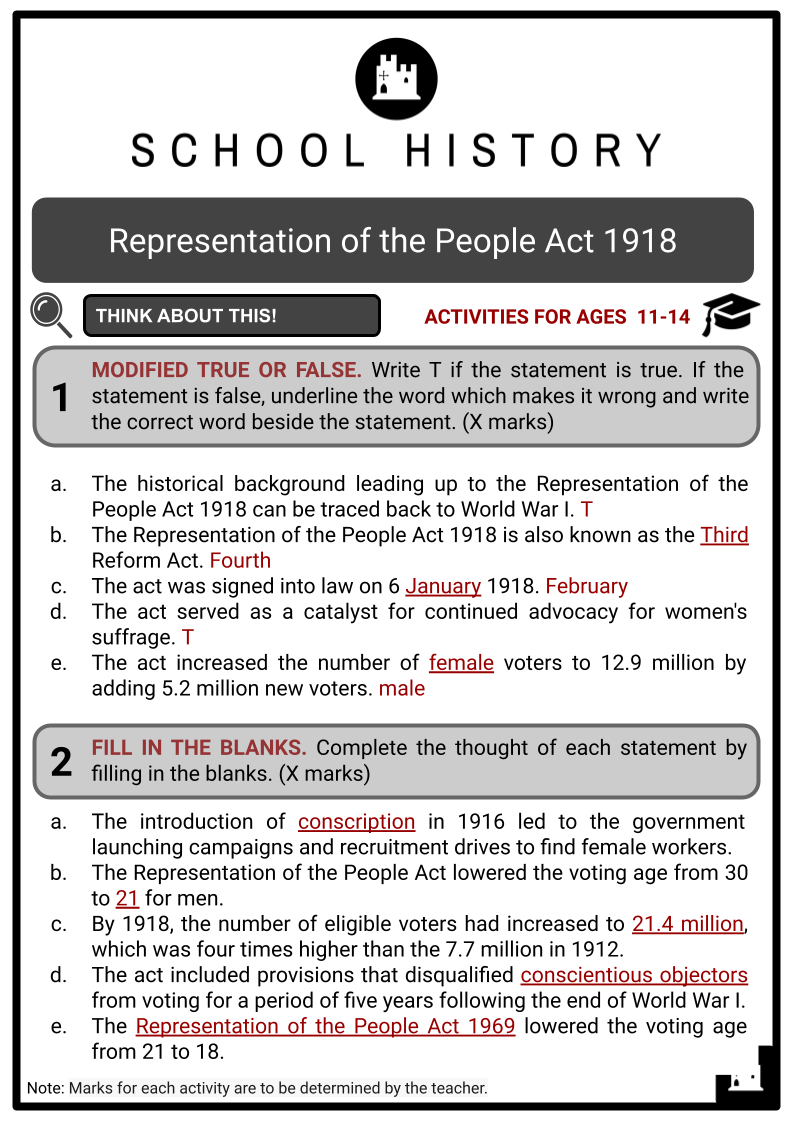
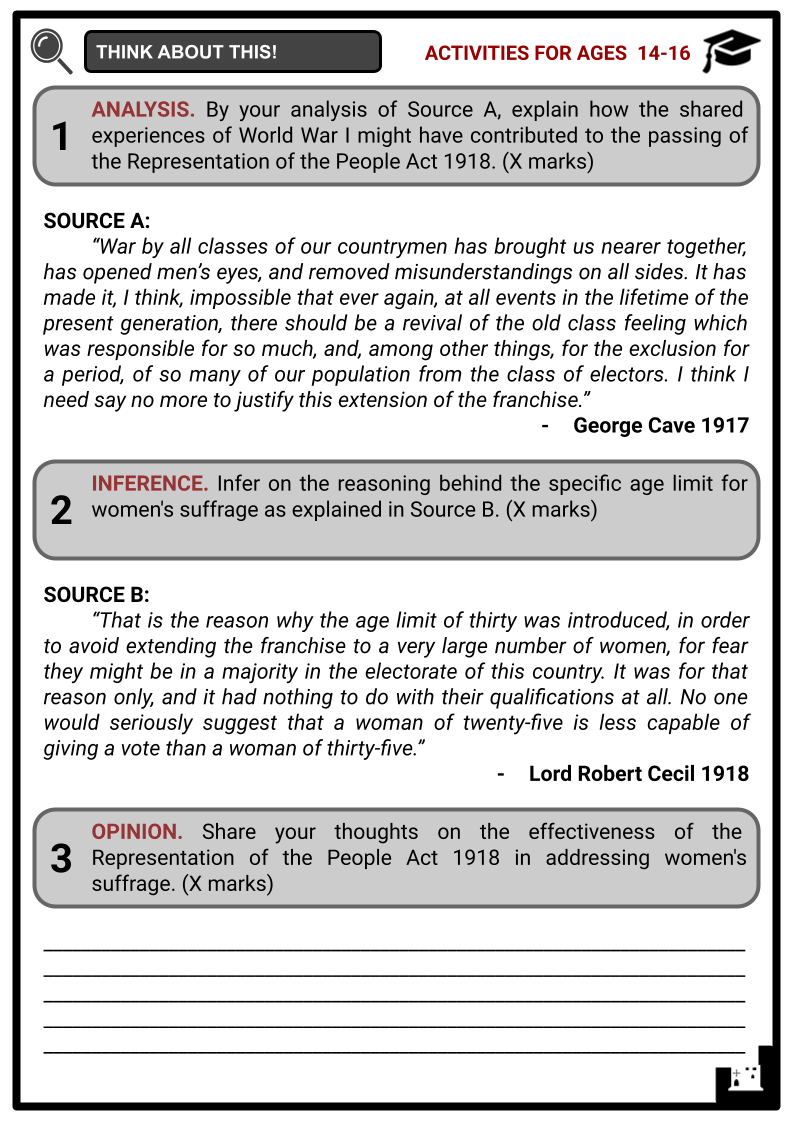
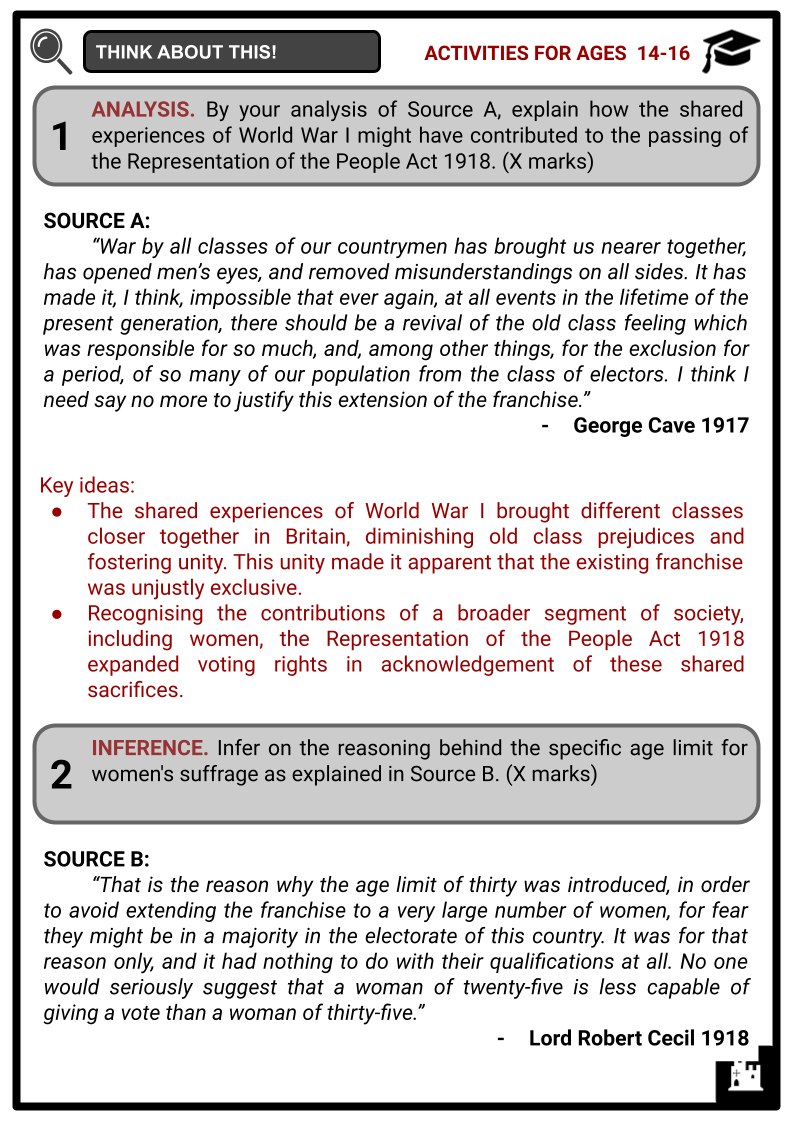
Summary
- Historical Background
- Provisions of the Act
- Effects on Women's Suffrage
- Implications for British Politics
- Weaknesses and Legislative Evolution
Key Facts And Information
Let’s know more about the Representation of the People Act 1918!
The Representation of the People Act 1918, also known as the Fourth Reform Act, signified a turning point in the extension of voting privileges, especially for women. It granted the vote to women over 30 who met certain property qualifications, as well as to all men over 21.
This was a significant step forward in the movement for universal suffrage and laid the foundation for further extensions of voting rights in the years to come. The act was a response to the contributions and sacrifices made by men and women during World War I, and it reflects the evolving attitudes towards democracy and representation in the early 20th century.
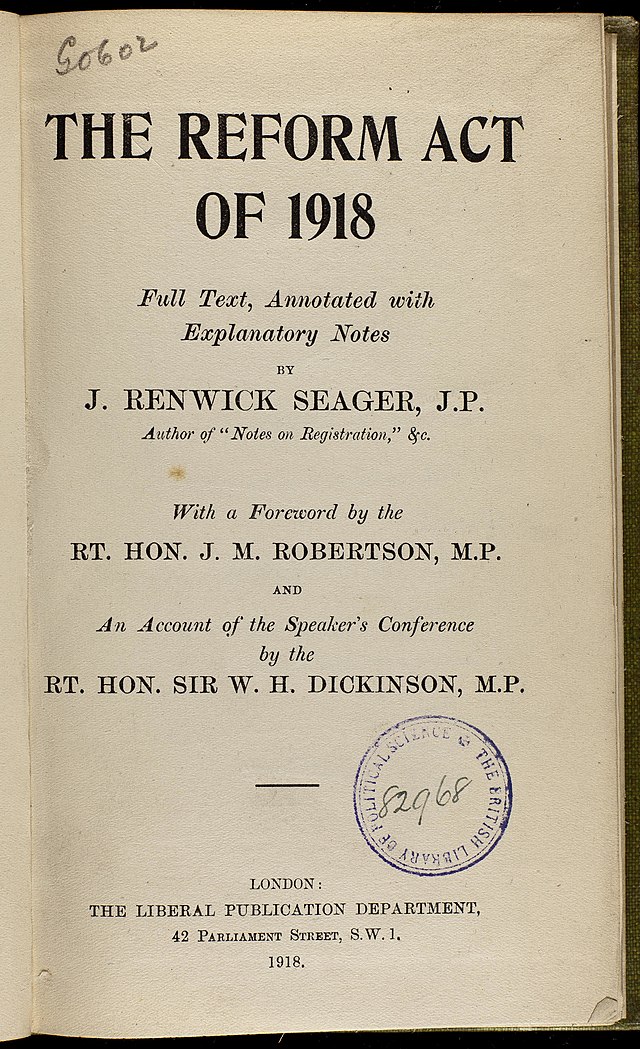
Historical Background
- The historical background leading up to the Representation of the People Act 1918 can be traced back to World War I, which emphasised the important role of women in society.
- The introduction of conscription in 1916 led to the government launching campaigns and recruitment drives to find female workers.
- Many women took jobs left by men who had gone to fight in the war, creating new jobs such as ammunition factory workers, railway guards, ticket collectors, bus and tram conductors, postal workers, police officers, firefighters, bank tellers and clerks.
- Women also made significant contributions through organisations such as the Women's Army Auxiliary Corps and Voluntary Aid Detachments, providing medical treatment to soldiers.
- The war created new job opportunities for women in military hospitals, with groups like the Medical Women's Federation sending doctors to support the war efforts.
- With the expansion of women's roles and the recognition of their contributions during the war, there was growing pressure for women to be granted the right to vote.
- With the suffrage movement, led by influential figures like Millicent Fawcett and Emmeline Pankhurst, gaining momentum, the demand for women's right to vote became a national priority.
- In addition to the suffrage movement, the rise of socialism and the increasing demand for social and political reforms created a climate where there was growing support for extending the franchise to a larger segment of the population.
- In response to this mounting pressure, the British government began to reconsider its stance on women's voting rights.
- In 1917, the Representation of the People Bill was introduced in Parliament. It underwent numerous debates and revisions before culminating in the Representation of the People Act 1918.
Provisions of the Act
- Also known as the Fourth Reform Act, the Representation of People Act 1918 was signed into law on 6 February 1918.
- The act expanded the right to vote by removing almost all property restrictions for men and granting voting rights to women over 30 who met the necessary property requirements.
Key provisions of the Representation of People Act 1918:
- Voting Age: The act lowered the voting age from 30 to 21 for men. This change significantly expanded the male electorate, allowing more men to participate in the political process.
- Women's Suffrage: The act granted limited voting rights to women. Women over the age of 30 who met certain property qualifications were allowed to vote, marking the first time that women in Britain were able to participate in parliamentary elections.
- Extension of the Franchise: The act extended the right to vote to all men over 21, removing property qualifications for male voters. This provision aimed to increase the inclusion of men in the electoral process and address disparities in the distribution of voting rights.
- Constituency Redistribution: The act introduced a redistribution of parliamentary constituencies, ensuring a more equitable distribution of representation based on population shifts and changes.
- Disqualification of Conscientious Objectors: The act included provisions that disqualified conscientious objectors from voting for a period of five years following the end of World War I. This provision reflected the social and political tensions surrounding the war and its aftermath.
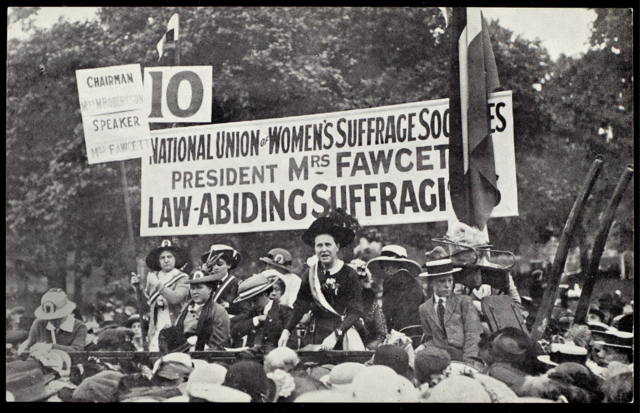
Conscientious objectors are individuals who refuse to participate in military service due to their personal beliefs, which are often based on religious, moral or ethical grounds. They may assert their objection to all forms of military activity, or just specific military actions they consider unjust or immoral.
Effects on Women's Suffrage
- The Representation of the People Act 1918 had significant impacts on women's right to vote and set the stage for further advancements in achieving gender equality. It marked the first time in the history of the United Kingdom that women were granted limited voting rights, allowing them to participate in parliamentary elections, although with certain property qualifications.
- The inclusion of women in the electoral process brought about a shift in the dynamics of political power. Women who met the criteria were now able to have a direct impact on the selection of their representatives and could voice their opinions on issues that directly affected their lives. These new political rights strengthened women and made them active participants in the democratic process.
- Furthermore, the act served as a catalyst for continued advocacy for women's suffrage. While the limited scope of the act fell short of full and equal voting rights for women, it created momentum for further progress. The visibility of women in the electoral process raised public awareness of the issue of women's suffrage and garnered support for broader enfranchisement.
- The Representation of the People Act 1918 also set a precedent for future legislative action regarding women's suffrage. Subsequent reforms, such as the Representation of the People Act 1928, further expanded women's voting rights, ultimately leading to full suffrage on equal terms with men in 1928.
Implications for British Politics
- The Representation of the People Act 1918 brought significant changes to the demographic make-up of the electorate. It extended voting rights to all men over 21 and granted limited rights to women over 30, thereby broadening the citizenry that could participate in the political process.
The age limit of 30 was imposed to prevent granting the right to vote to a significant number of women out of concern that they might eventually make up the majority of voters in the country.
- By 1918, the number of eligible voters had increased to 21.4 million, which was four times higher than the 7.7 million in 1912.
- The act increased the number of male voters to 12.9 million by adding 5.2 million new voters, while there were also around 8.5 million women in the electorate.
- This expansion of the franchise had immediate and long-term implications for British politics, as it necessitated a shift in the strategies and priorities of political parties. The parties needed to adjust their approach to appeal to a broader and more diverse group of voters, prompting them to focus on addressing issues that were especially important for women and younger voters.
- The act also had implications for the political representation of diverse interests within the UK.
- With a broader electorate, politicians were increasingly accountable to a wider range of constituents, including women and younger voters who had previously been excluded from the electoral process. This fostered a more representative and inclusive political system where the concerns and perspectives of a more diverse population could be addressed and reflected in the policymaking process.
- The act also contributed to the reconfiguration of power dynamics within political institutions. The inclusion of women in the electorate meant that their interests and priorities could no longer be ignored or marginalised.
- As a result, the act contributed to the gradual transformation of British politics towards a more gender-inclusive and egalitarian system. Furthermore, the act had implications for the relationship between the government and its citizens.
- The expansion of the franchise and increased participation in politics strengthened the idea of popular sovereignty and highlighted the significance of involving citizens in decision-making. This had the effect of enhancing the legitimacy of the political system and reinforcing the bond between the government and the governed.
Weaknesses and Legislative Evolution
- Despite being a step forward in British suffrage, the Representation of the People Act 1918 also had its weaknesses. One is that it granted the right to vote only to women over the age of 30 who met certain property qualifications. This restriction meant that a large number of women, particularly the younger and working class, remained disenfranchised.
- The act's property requirements also maintained socio-economic barriers to political participation. While the act removed property qualifications for men, the gendered disparity in the age requirement reflected and maintained gender inequality within the political system. Additionally, the disenfranchisement of conscientious objectors imposed a penalty based on personal beliefs and could be viewed as a form of ideological discrimination.
- The legislative evolution of the Representation of the People Act 1918 reflects the ongoing commitment to expanding and refining electoral laws in the United Kingdom.
- The Equal Franchise Act of 1928 stands as a significant milestone in the progression towards gender equality in voting rights.
- This legislation extended voting rights to all women over the age of 21, aligning their suffrage with that of men.
- By eradicating the age distinction for women voters, this act further advanced the principle of equal suffrage.
- Building on the Representation of the People Act 1918's foundation, the Representation of the People Act 1949 introduced additional improvements and updates to electoral procedures. This demonstrated a persistent commitment to improving the electoral process and ensuring the integrity of democratic representation.
- Additionally, the Representation of the People Act 1969 lowered the voting age from 21 to 18. This effectively recognised the political agency of younger citizens. These changes in legislation collectively represent a forward-thinking direction in the development of electoral laws and practices in the United Kingdom.
Image Sources
- https://upload.wikimedia.org/wikipedia/commons/thumb/2/22/Representation_of_the_People_Act_1918_%2822792705701%29.jpg/640px-Representation_of_the_People_Act_1918_%2822792705701%29.jpg
- https://upload.wikimedia.org/wikipedia/commons/thumb/4/47/Millicent_Fawcett_durante_il_%22Suffrage_pilgrimage%22%2C_Hyde_Park%2C_1913.png/640px-Millicent_Fawcett_durante_il_%22Suffrage_pilgrimage%22%2C_Hyde_Park%2C_1913.png
Frequently Asked Questions
- What was the Representation of the People Act 1918?
The Representation of the People Act 1918 was legislation passed by the British Parliament that extended the right to vote to certain groups of people in the United Kingdom.
- What were the main provisions of the Representation of the People Act 1918?
The Act extended the right to vote to men over the age of 21 and women over 30 who met specific property qualifications. It also abolished plural voting and introduced a system of single-member constituencies.
- Why was the Representation of the People Act 1918 significant?
The Act was significant because it greatly expanded the electorate in the United Kingdom, mainly by granting a group of women the right to vote for the first time. It was a significant step towards universal suffrage in Britain.
